Estimation and Analysis of Air Pollutant Emissions from On-Road Vehicles in Changzhou, China
Abstract
1. Introduction
2. Methods and Data
2.1. Study Area
2.2. Vehicle Emission Estimation
2.3. Detailed Vehicle Population
2.4. Annual and Monthly VKT
2.5. Emission Factor Simulation
2.6. Emission Spatial Allocation
- (1)
- Establishing the target domain. The digital road network map of Changzhou was re-gridded into 4481 grids, each with a horizontal resolution of 0.01° × 0.01° on the WGS84 datum, using ArcGIS software (version 10.4.1) [39].
- (2)
- Allocating emissions from city to district level. Owing to limited data availability on vehicle populations at the district level, socioeconomic indicators, such as population, were employed to allocate emissions from Changzhou to its constituent districts.
- (3)
- Assigning emissions to road types. Vehicles have different travel frequencies on different road types, which are described by mileage weights. In this study, mileage weights were used to assign vehicle emissions to specific road types according to the following equation:where dist and r represent the districts of Changzhou and road types, respectively (see Section 2.1 for details), and MW refers to mileage weights expressed as percentages and obtained from previous studies (see Table 2). As passenger vehicles predominantly operate in urban areas, their mileage weights are higher on streets, while trucks, primarily used for freight transportation and subject to traffic restrictions, have higher mileage weights on highways and arterials.
- (4)
- Calculating road emission intensity. This metric is determined by considering the emissions and lengths of different road types within each district, as expressed in the equation:where EIp,dist,r represents the emission intensity of pollutant p on road type r in district dist, while Ep,dist,r denotes the corresponding total emissions. RLdist,r is the total length of road type r in district dist, calculated using ArcGIS.
- (5)
- Simulating gridded vehicle emissions. Since a grid can include multiple road types, gridded emissions are calculated as the sum of the products of emission intensity and road length for each road type within the grid, as follows:where g is the grid cell number, Ep,dist,g represents the emissions of pollutant p within grid g in district dist, and RLdist,g,r denotes the length of road type r within grid g, obtained by ArcGIS.
3. Results and Discussion
3.1. Total Emissions and Composition
3.2. Emissions by Fuel and Standard
3.3. Monthly Vehicle Emissions
3.4. Spatial Distribution Characteristics
3.5. Uncertainty Analysis
4. Conclusions
Author Contributions
Funding
Institutional Review Board Statement
Informed Consent Statement
Data Availability Statement
Acknowledgments
Conflicts of Interest
References
- Zhang, Q.; Zheng, Y.; Tong, D.; Shao, M.; Wang, S.; Zhang, Y.; Xu, X.; Wang, J.; He, H.; Liu, W.; et al. Drivers of Improved PM2.5 Air Quality in China from 2013 to 2017. Proc. Natl. Acad. Sci. USA 2019, 116, 24463–24469. [Google Scholar] [CrossRef]
- Li, S.; Wang, S.; Wu, Q.; Zhang, Y.; Ouyang, D.; Zheng, H.; Han, L.; Qiu, X.; Wen, Y.; Liu, M.; et al. Emission Trends of Air Pollutants and CO2 in China from 2005 to 2021. Earth Syst. Sci. Data 2023, 15, 2279–2294. [Google Scholar] [CrossRef]
- Cheng, J.; Tong, D.; Liu, Y.; Geng, G.; Davis, S.J.; He, K.; Zhang, Q. A Synergistic Approach to Air Pollution Control and Carbon Neutrality in China Can Avoid Millions of Premature Deaths Annually by 2060. One Earth 2023, 6, 978–989. [Google Scholar] [CrossRef]
- National Bureau of Statistics. National Data. Available online: http://data.stats.gov.cn/ (accessed on 9 January 2024).
- Liu, G.; Sun, S.; Zou, C.; Wang, B.; Wu, L.; Mao, H. Air Pollutant Emissions from On-Road Vehicles and Their Control in Inner Mongolia, China. Energy 2022, 238, 121724. [Google Scholar] [CrossRef]
- Sun, S.; Sun, L.; Liu, G.; Zou, C.; Wang, Y.; Wu, L.; Mao, H. Developing a Vehicle Emission Inventory with High Temporal-Spatial Resolution in Tianjin, China. Sci. Total Environ. 2021, 776, 145873. [Google Scholar] [CrossRef]
- Sun, S.; Jiang, W.; Gao, W. Vehicle Emission Trends and Spatial Distribution in Shandong Province, China, from 2000 to 2014. Atmos. Environ. 2016, 147, 190–199. [Google Scholar] [CrossRef]
- Cai, H.; Xie, S. Estimation of Vehicular Emission Inventories in China from 1980 to 2005. Atmos. Environ. 2007, 41, 8963–8979. [Google Scholar] [CrossRef]
- Cai, H.; Xie, S. Temporal and Spatial Variation in Recent Vehicular Emission Inventories in China Based on Dynamic Emission Factors. J. Air Waste Manag. Assoc. 2013, 63, 310–326. [Google Scholar] [CrossRef] [PubMed]
- Zheng, B.; Huo, H.; Zhang, Q.; Yao, Z.L.; Wang, X.T.; Yang, X.F.; Liu, H.; He, K.B. High-Resolution Mapping of Vehicle Emissions in China in 2008. Atmos. Chem. Phys. 2014, 14, 9787–9805. [Google Scholar] [CrossRef]
- Jia, T.; Li, Q.; Shi, W. Estimation and Analysis of Emissions from On-Road Vehicles in Mainland China for the Period 2011–2015. Atmos. Environ. 2018, 191, 500–512. [Google Scholar] [CrossRef]
- Wen, Y.; Liu, M.; Zhang, S.; Wu, X.; Wu, Y.; Hao, J. Updating On-Road Vehicle Emissions for China: Spatial Patterns, Temporal Trends, and Mitigation Drivers. Environ. Sci. Technol. 2023, 57, 14299–14309. [Google Scholar] [CrossRef] [PubMed]
- Liu, Y.-H.; Liao, W.-Y.; Li, L.; Huang, Y.-T.; Xu, W.-J. Vehicle Emission Trends in China’s Guangdong Province from 1994 to 2014. Sci. Total Environ. 2017, 586, 512–521. [Google Scholar] [CrossRef] [PubMed]
- Lv, W.; Hu, Y.; Li, E.; Liu, H.; Pan, H.; Ji, S.; Hayat, T.; Alsaedi, A.; Ahmad, B. Evaluation of Vehicle Emission in Yunnan Province from 2003 to 2015. J. Clean. Prod. 2019, 207, 814–825. [Google Scholar] [CrossRef]
- Xu, Z.; Chen, S.; Sang, M.; Wang, Z.; Bo, X.; You, Q. Air Quality Improvement through Vehicle Electrification in Hainan Province, China. Chemosphere 2023, 316, 137814. [Google Scholar] [CrossRef] [PubMed]
- Jing, B.; Wu, L.; Mao, H.; Gong, S.; He, J.; Zou, C.; Song, G.; Li, X.; Wu, Z. Development of a Vehicle Emission Inventory with High Temporal–Spatial Resolution Based on NRT Traffic Data and Its Impact on Air Pollution in Beijing—Part 1: Development and Evaluation of Vehicle Emission Inventory. Atmos. Chem. Phys. 2016, 16, 3161–3170. [Google Scholar] [CrossRef]
- Zou, C.; Wu, L.; Wang, Y.; Sun, S.; Wei, N.; Sun, B.; Ni, J.; He, J.; Zhang, Q.; Peng, J.; et al. Evaluating Traffic Emission Control Policies Based on Large-Scale and Real-Time Data: A Case Study in Central China. Sci. Total Environ. 2023, 860, 160435. [Google Scholar] [CrossRef] [PubMed]
- Zhu, C.; Qu, X.; Qiu, M.; Zhu, C.; Wang, C.; Wang, B.; Sun, L.; Yang, N.; Yan, G.; Xu, C.; et al. High Spatiotemporal Resolution Vehicular Emission Inventory in Beijing-Tianjin-Hebei and Its Surrounding Areas (BTHSA) during 2000–2020, China. Sci. Total Environ. 2023, 873, 162389. [Google Scholar] [CrossRef] [PubMed]
- Chen, S.; Du, Z.; Shi, X.; Liu, Y.; Li, S.; Shao, C.; Steve-Harold, K.W. MOVES-Beijing-Based High Spatial and Temporal Resolution Ammonia Emissions from Road Traffic in Beijing. Atmos. Environ. 2021, 256, 118443. [Google Scholar] [CrossRef]
- Liu, H.; He, K.; Wang, Q.; Huo, H.; Lents, J.; Davis, N.; Nikkila, N.; Chen, C.; Osses, M.; He, C. Comparison of Vehicle Activity and Emission Inventory between Beijing and Shanghai. J. Air Waste Manag. Assoc. 2007, 57, 1172–1177. [Google Scholar] [CrossRef] [PubMed]
- Ministry of Ecology and Environment. Announcement on the Release of Five National Technical Guidelines of Air Pollutant Emission Inventory. Available online: https://www.mee.gov.cn/gkml/hbb/bgg/201501/t20150107_293955.htm (accessed on 18 December 2023).
- Liu, Z.; Hu, K.; Zhang, K.; Zhu, S.; Wang, M.; Li, L. VOCs Sources and Roles in O3 Formation in the Central Yangtze River Delta Region of China. Atmos. Environ. 2023, 302, 119755. [Google Scholar] [CrossRef]
- Sun, S.; Jiang, W.; Gao, W. Vehicle Emission Inventory and Spatial Distribution in Qingdao. China Environ. Sci. 2017, 37, 49–59. [Google Scholar] [CrossRef]
- Hao, Y.; Song, X. Research on Trends and Spatial Distribution of Vehicular Emissions and Its Control Measure Assessment in the Yangtze River Delta, China, for 1999–2015. Environ. Sci. Pollut. Res. 2018, 25, 36503–36517. [Google Scholar] [CrossRef] [PubMed]
- Sun, S.; Wang, B.; Sun, L.; Huang, X.; Wang, X.; Zhang, S.; Bo, Y. Development and Characteristics of Vehicle Emission Inventory with High Spatiotemporal Resolution in Jiangsu Province. China Environ. Sci. 2023, 43, 4490–4502. [Google Scholar] [CrossRef]
- Huang, C.; Wang, H.L.; Li, L.; Wang, Q.; Lu, Q.; De Gouw, J.A.; Zhou, M.; Jing, S.A.; Lu, J.; Chen, C.H. VOC Species and Emission Inventory from Vehicles and Their SOA Formation Potentials Estimation in Shanghai, China. Atmos. Chem. Phys. 2015, 15, 11081–11096. [Google Scholar] [CrossRef]
- Zhang, S.; Niu, T.; Wu, Y.; Zhang, K.M.; Wallington, T.J.; Xie, Q.; Wu, X.; Xu, H. Fine-Grained Vehicle Emission Management Using Intelligent Transportation System Data. Environ. Pollut. 2018, 241, 1027–1037. [Google Scholar] [CrossRef] [PubMed]
- Sun, L.; Zhong, C.; Peng, J.; Wang, T.; Wu, L.; Liu, Y.; Sun, S.; Li, Y.; Chen, Q.; Song, P.; et al. Refueling Emission of Volatile Organic Compounds from China 6 Gasoline Vehicles. Sci. Total Environ. 2021, 789, 147883. [Google Scholar] [CrossRef]
- Sun, L.; Zhong, C.; Sun, S.; Liu, Y.; Tong, H.; Wu, Y.; Song, P.; Zhang, L.; Huang, X.; Wu, L.; et al. Evolution and Characteristics of Full-process Vehicular VOCs Emissions in Tianjin from 2000 to 2020. Environ. Sci. 2023, 44, 1346–1356. [Google Scholar] [CrossRef]
- Liu, Y.; Zhong, C.; Peng, J.; Wang, T.; Wu, L.; Chen, Q.; Sun, L.; Sun, S.; Zou, C.; Zhao, J.; et al. Evaporative Emission from China 5 and China 6 Gasoline Vehicles: Emission Factors, Profiles and Future Perspective. J. Clean. Prod. 2022, 331, 129861. [Google Scholar] [CrossRef]
- Sun, S.; Zhao, G.; Wang, T.; Jin, J.; Wang, P.; Lin, Y.; Li, H.; Ying, Q.; Mao, H. Past and Future Trends of Vehicle Emissions in Tianjin, China, from 2000 to 2030. Atmos. Environ. 2019, 209, 182–191. [Google Scholar] [CrossRef]
- Sun, S.; Jin, J.; Xia, M.; Liu, Y.; Gao, M.; Zou, C.; Wang, T.; Lin, Y.; Wu, L.; Mao, H.; et al. Vehicle Emissions in a Middle-Sized City of China: Current Status and Future Trends. Environ. Int. 2020, 137, 105514. [Google Scholar] [CrossRef]
- Liu, G.; Sun, S.; Sun, L.; Jin, J.; Fang, J.; Song, P.; Wang, T.; Wu, L.; Mao, H. Mobile Source Emission Inventory with High Spatiotemporal Resolution in Tianjin in 2017. Environ. Sci. 2020, 41, 4470–4481. [Google Scholar] [CrossRef]
- Sun, S.; Jin, J.; Lv, J.; Sun, L.; Zou, C.; Liu, Y.; Liu, G.; Wang, T.; Wu, L.; Mao, H. Developing Vehicle Emission Inventory Based on Refined Annual Average Vehicle Kilometers Traveled. China Environ. Sci. 2020, 40, 2018–2029. [Google Scholar] [CrossRef]
- Huo, H.; Zhang, Q.; He, K.; Yao, Z.; Wang, M. Vehicle-Use Intensity in China: Current Status and Future Trend. Energy Policy 2012, 43, 6–16. [Google Scholar] [CrossRef]
- Zheng, B.; Zhang, Q.; Geng, G.; Chen, C.; Shi, Q.; Cui, M.; Lei, Y.; He, K. Changes in China’s Anthropogenic Emissions and Air Quality during the COVID-19 Pandemic in 2020. Earth Syst. Sci. Data 2021, 13, 2895–2907. [Google Scholar] [CrossRef]
- Changzhou Municipal Bureau of Statistics. Changzhou Statistical Yearbook. Available online: https://tjj.changzhou.gov.cn/class/MFCMMFBD (accessed on 14 December 2023).
- Liu, Y.-H.; Ma, J.-L.; Li, L.; Lin, X.-F.; Xu, W.-J.; Ding, H. A High Temporal-Spatial Vehicle Emission Inventory Based on Detailed Hourly Traffic Data in a Medium-Sized City of China. Environ. Pollut. 2018, 236, 324–333. [Google Scholar] [CrossRef]
- Lotrecchiano, N.; Sofia, D.; Giuliano, A.; Barletta, D.; Poletto, M. Real-Time On-Road Monitoring Network of Air Quality. Chem. Eng. Trans. 2019, 74, 241–246. [Google Scholar] [CrossRef]
- Wu, T.; Cui, Y.; Lian, A.; Tian, Y.; Li, R.; Liu, X.; Yan, J.; Xue, Y.; Liu, H.; Wu, B. Vehicle Emissions of Primary Air Pollutants from 2009 to 2019 and Projection for the 14th Five-Year Plan Period in Beijing, China. J. Environ. Sci. 2023, 124, 513–521. [Google Scholar] [CrossRef]
- Jiang, P.; Zhong, X.; Li, L. On-Road Vehicle Emission Inventory and Its Spatio-Temporal Variations in North China Plain. Environ. Pollut. 2020, 267, 115639. [Google Scholar] [CrossRef] [PubMed]
- Cheng, S.; Zhang, B.; Zhao, Y.; Peng, P.; Lu, F. Multiscale Spatiotemporal Variations of NOx Emissions from Heavy Duty Diesel Trucks in the Beijing-Tianjin-Hebei Region. Sci. Total Environ. 2023, 854, 158753. [Google Scholar] [CrossRef] [PubMed]
- Ministry of Industry and Information Technology. Notice on Organizing and Carrying out the Pilot Work of the Leading Area for Comprehensive Electrification of Vehicles in Public Spaces. Available online: https://www.gov.cn/zhengce/zhengceku/2023-02/03/content_5739955.htm?ivk_sa=1023197a (accessed on 21 December 2023).
- Yan, L.; Zheng, B.; Geng, G.; Hong, C.; Tong, D.; Zhang, Q. Evaporation Process Dominates Vehicular NMVOC Emissions in China with Enlarged Contribution from 1990 to 2016. Environ. Res. Lett. 2021, 16, 124036. [Google Scholar] [CrossRef]
- Sun, S.; Zhang, G.; Sun, L.; Xu, C.; Guo, M.; Cui, Z.; He, X.; Li, F.; Song, Z.; Bo, Y.; et al. Synergistic Benefits of Pollution and Carbon Reduction from Air Pollution Control in Hebei Province from 2013 to 2020. Environ. Sci. 2023, 44, 5431–5442. [Google Scholar] [CrossRef]
- Wang, X.; Xiao, R.; Zhao, N. Analysis of the Pandemic’s Impact on the Logistics Supply Chain in the Yangtze River Delta Region Based on Dynamic Data from Heavy Trucks. China Logist. Purch. 2023, 44, 38–40. [Google Scholar] [CrossRef]
- Zhao, D.; Lei, Y.; Zhang, Y.; Shi, X.; Liu, X.; Xu, Y.; Xue, W. Analysis of Vehicular CO2 Emission in the Central Plains of China and Its Driving Forces. Sci. Total Environ. 2022, 814, 152758. [Google Scholar] [CrossRef] [PubMed]
- Song, X.; Hao, Y.; Zhang, C.; Peng, J.; Zhu, X. Vehicular Emission Trends in the Pan-Yangtze River Delta in China between 1999 and 2013. J. Clean. Prod. 2016, 137, 1045–1054. [Google Scholar] [CrossRef]
- Gong, M.; Yin, S.; Gu, X.; Xu, Y.; Jiang, N.; Zhang, R. Refined 2013-Based Vehicle Emission Inventory and Its Spatial and Temporal Characteristics in Zhengzhou, China. Sci. Total Environ. 2017, 599–600, 1149–1159. [Google Scholar] [CrossRef] [PubMed]
- Yu, J.; Zhou, L.; Tang, G.; Wang, G.; Yu, M.; Ding, J.; Shen, G. Study on Distribution Characteristics of Motor Vehicle Emission Pollution and Its Coupling with Air Quality in Jiangsu Province in 2020. Environ. Monit. Forewarning 2022, 14, 53–57. [Google Scholar] [CrossRef]
- Li, L.; Zhang, J.; Zhao, Q.; Li, H.; Han, J. Vehicle Exhaust Emission Characteristics and Their Contributions in Jiangsu Province. Environ. Sci. 2018, 39, 3976–3986. [Google Scholar] [CrossRef]
- Gao, S.; Zhu, D.; Yang, X. Air Pollution Emission Inventory Based on GIS in Changzhou City. Environ. Sci. Technol. 2015, 38, 241–246. [Google Scholar] [CrossRef]

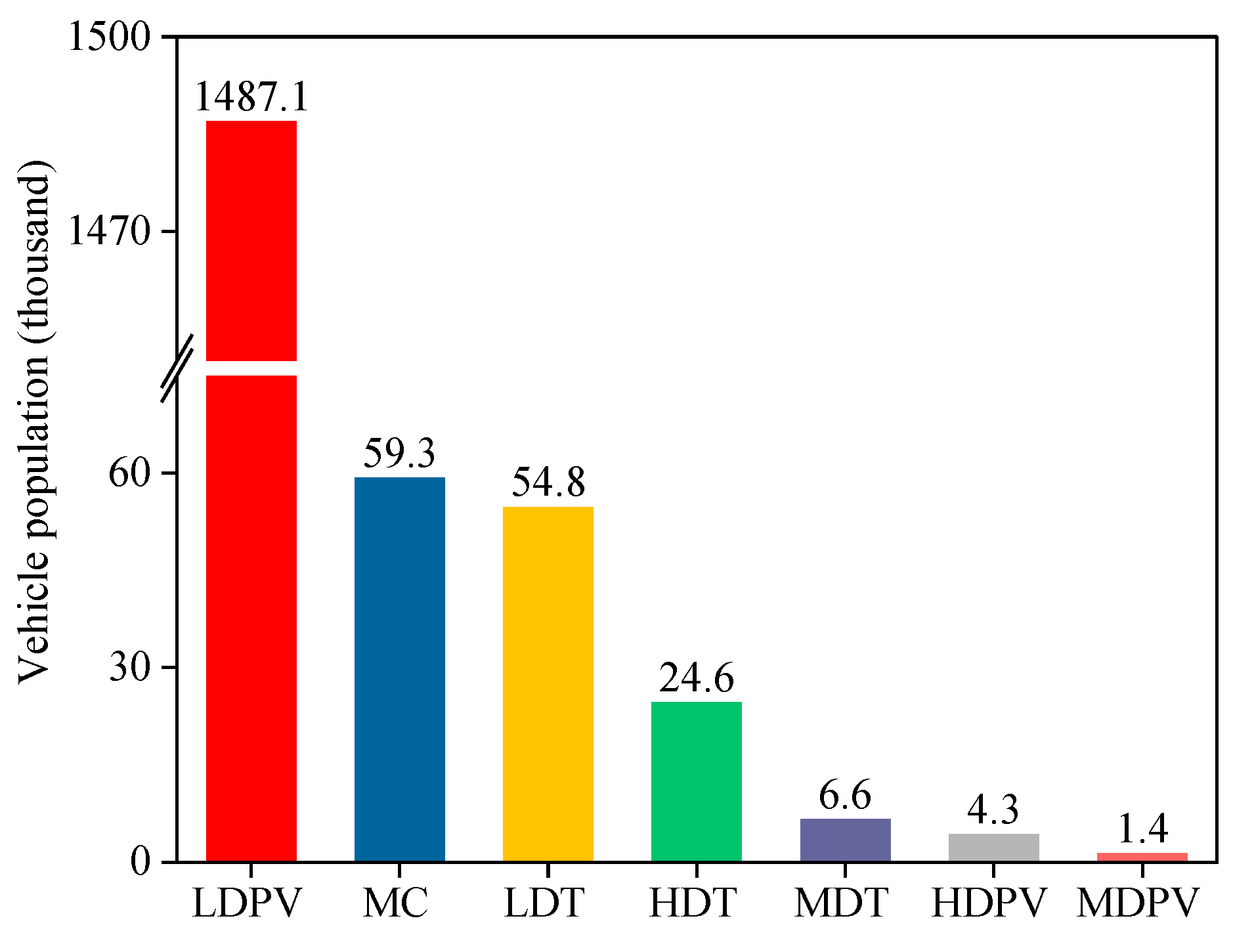
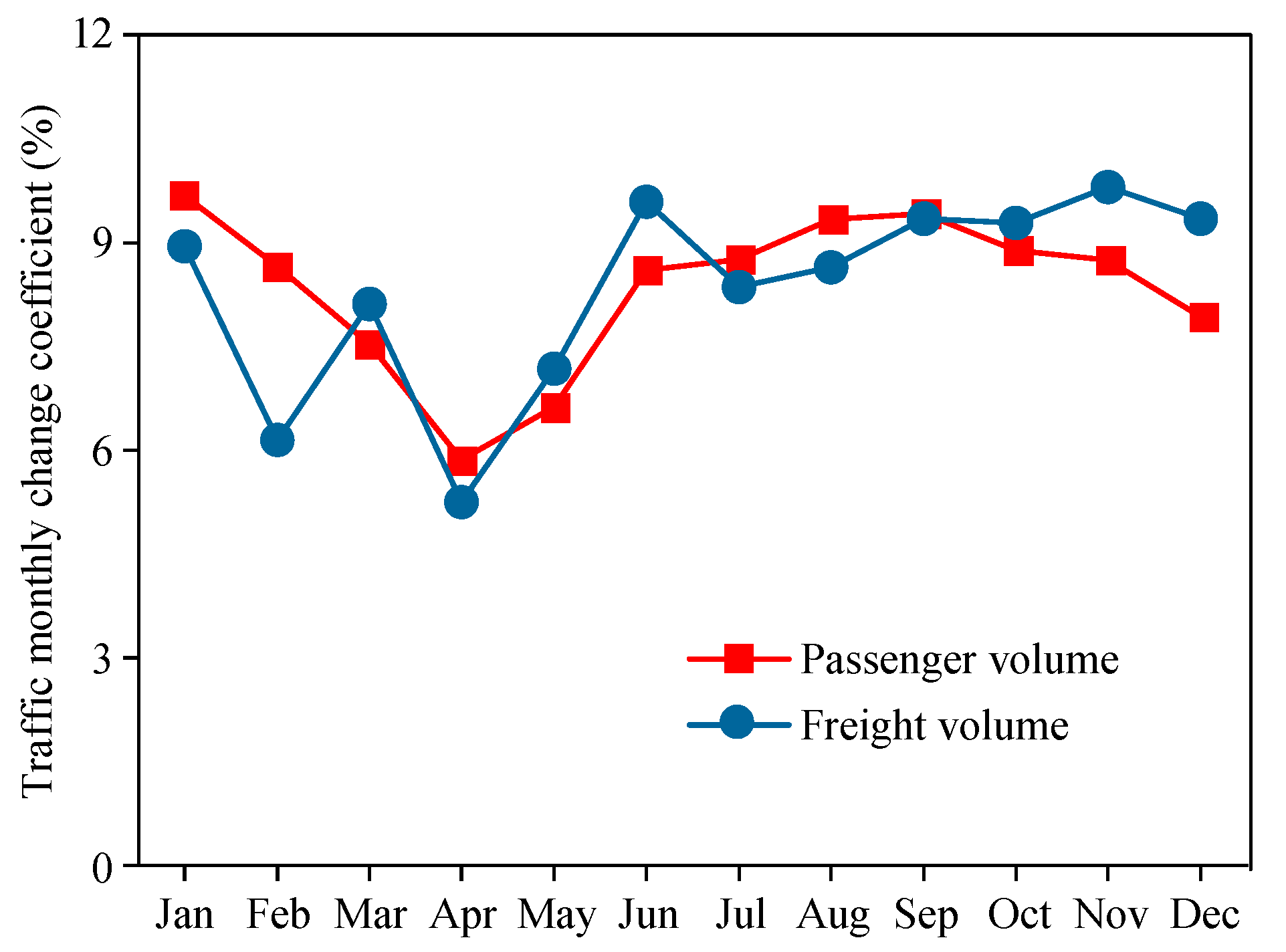

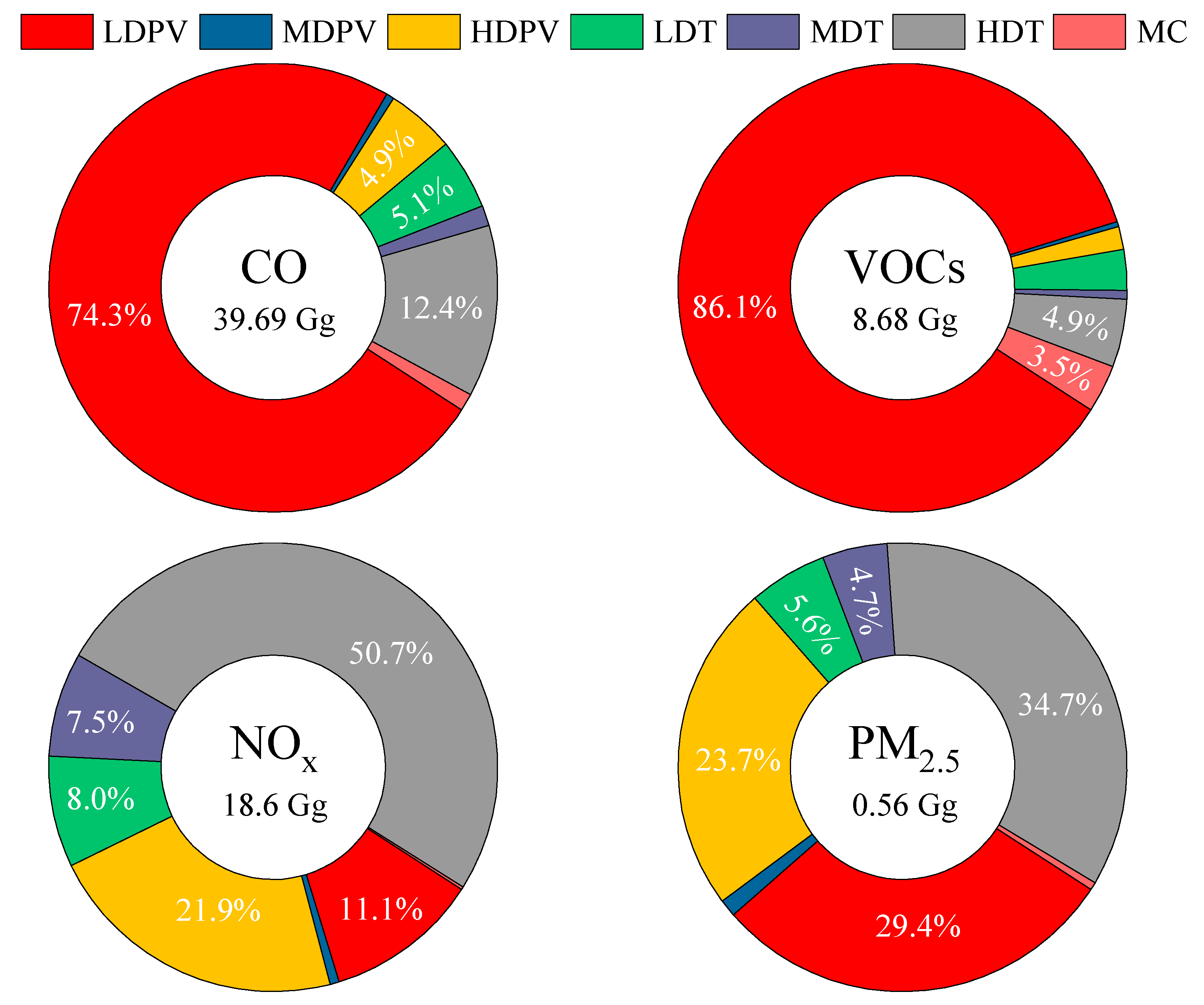
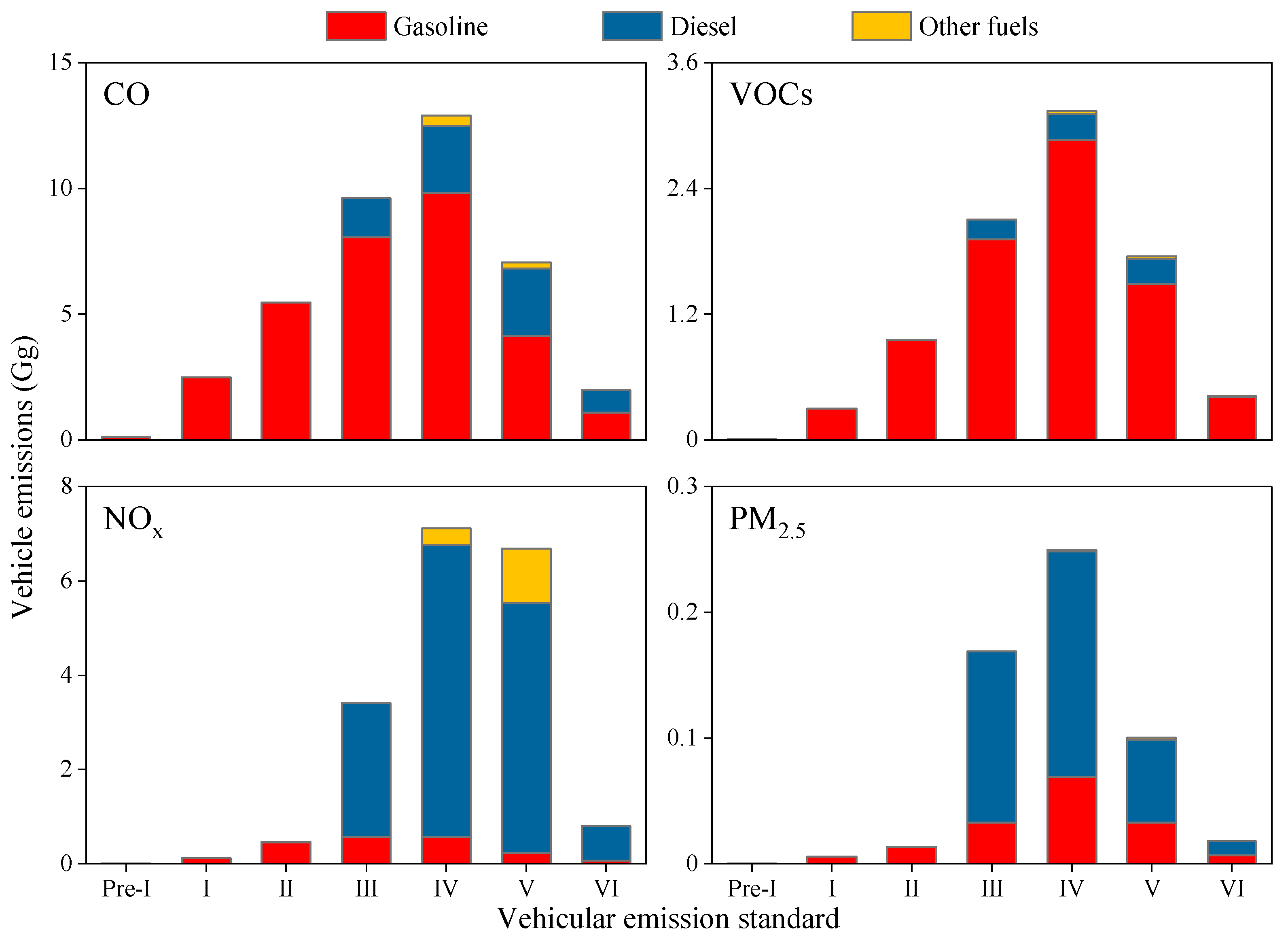
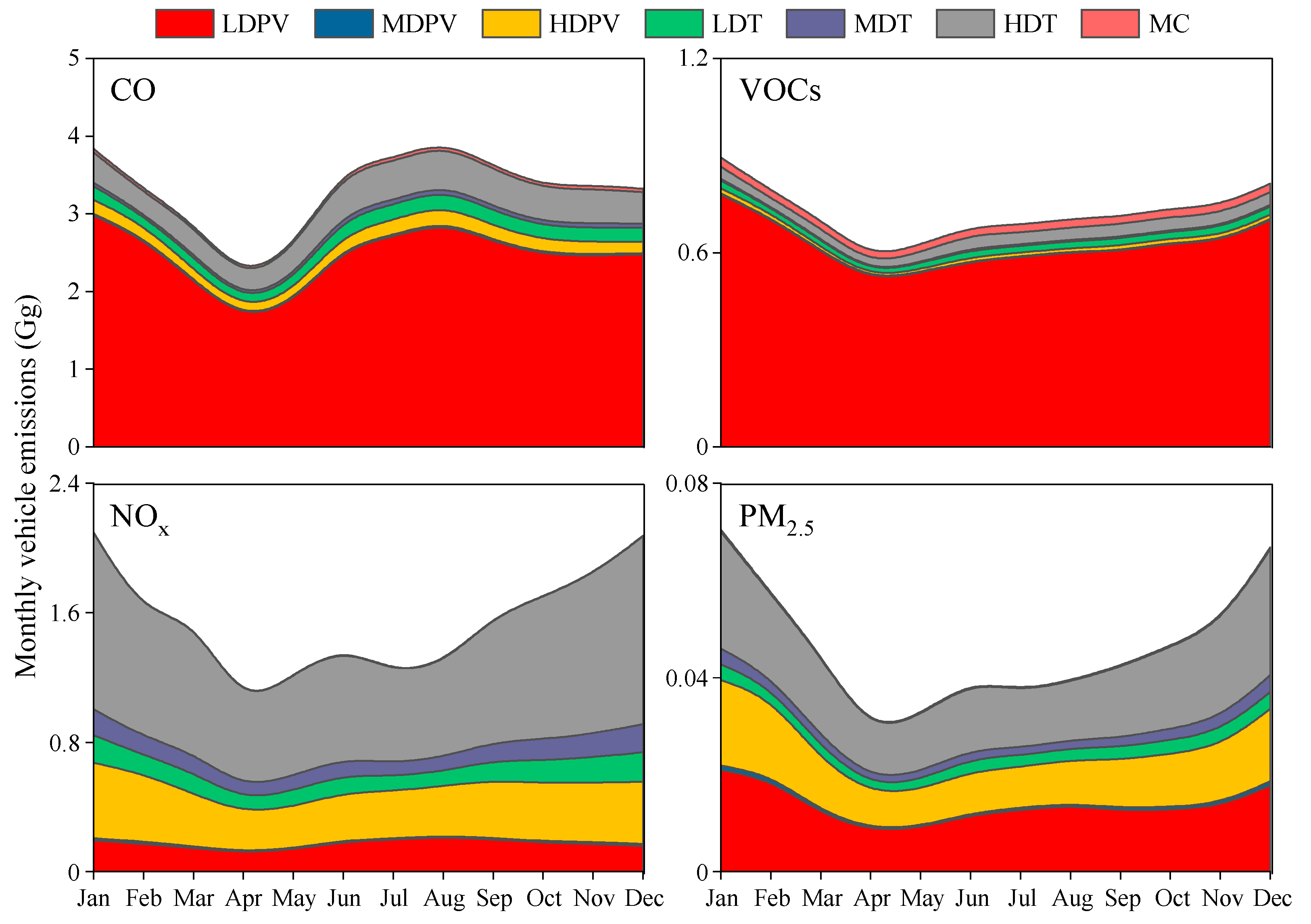
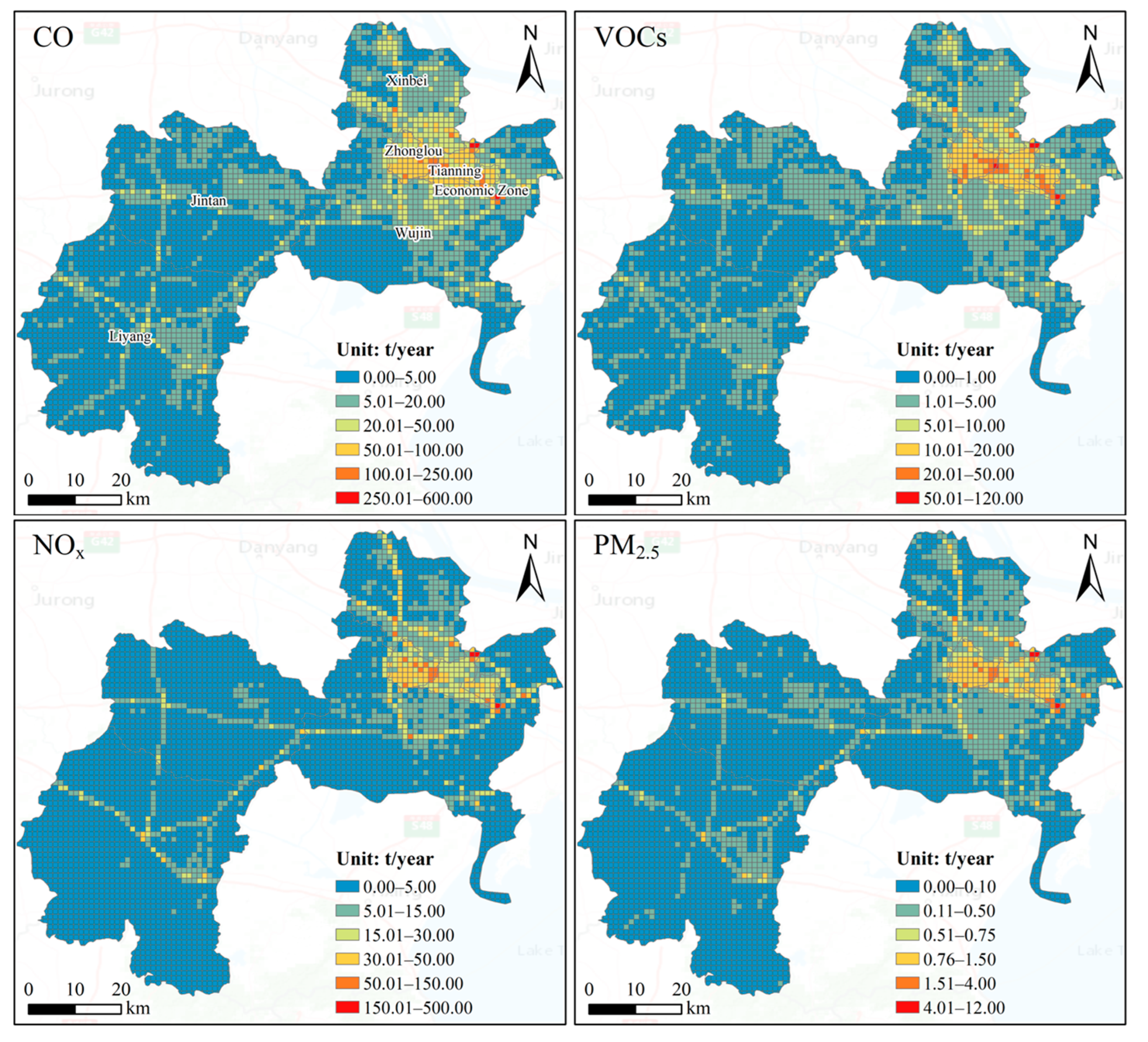
| Vehicle Type | VKT (km/Year) | Average Speed (km/h) |
|---|---|---|
| LDPV | 12,464 | 22 |
| MDPV | 31,300 | 18 |
| HDPV | 81,683 | 18 |
| LDT | 22,203 | 35 |
| MDT | 60,000 | 39.5 |
| HDT | 80,782 | 39.5 |
| MC | 7303 | 28 |
| Vehicle Type | Highways | Arterials | Streets |
|---|---|---|---|
| LDPV | 18 | 22 | 60 |
| MDPV/HDPV | 25 | 25 | 50 |
| LDT | 40 | 40 | 20 |
| MDT/HDT | 50 | 40 | 10 |
| MC | 2 | 49 | 49 |
| Studies | Year | Vehicle Population | CO | VOCs | NOx | PM2.5 |
|---|---|---|---|---|---|---|
| This study | 2022 | 1637.98 | 39.69 | 8.68 | 18.60 | 0.56 |
| Yu et al. [50] | 2020 | 1565.31 | - | 8.25 | 22.15 | 0.29 |
| Sun et al. [25] | 2018 | 1412.90 | 58.95 | 11.44 | 42.34 | 1.48 |
| Li et al. [51] | 2015 | 1103.24 | 84.30 | 8.40 | 28.90 | 1.00 |
| Gao et al. [52] | 2010 | 869.19 | 87.33 | 10.01 | 13.60 | 0.82 |
Disclaimer/Publisher’s Note: The statements, opinions and data contained in all publications are solely those of the individual author(s) and contributor(s) and not of MDPI and/or the editor(s). MDPI and/or the editor(s) disclaim responsibility for any injury to people or property resulting from any ideas, methods, instructions or products referred to in the content. |
© 2024 by the authors. Licensee MDPI, Basel, Switzerland. This article is an open access article distributed under the terms and conditions of the Creative Commons Attribution (CC BY) license (https://creativecommons.org/licenses/by/4.0/).
Share and Cite
Guo, M.; Ning, M.; Sun, S.; Xu, C.; Zhang, G.; Zhang, L.; Zhang, R.; Zheng, J.; Chen, C.; Jia, Z.; et al. Estimation and Analysis of Air Pollutant Emissions from On-Road Vehicles in Changzhou, China. Atmosphere 2024, 15, 192. https://doi.org/10.3390/atmos15020192
Guo M, Ning M, Sun S, Xu C, Zhang G, Zhang L, Zhang R, Zheng J, Chen C, Jia Z, et al. Estimation and Analysis of Air Pollutant Emissions from On-Road Vehicles in Changzhou, China. Atmosphere. 2024; 15(2):192. https://doi.org/10.3390/atmos15020192
Chicago/Turabian StyleGuo, Mengjie, Miao Ning, Shida Sun, Chenxi Xu, Gaige Zhang, Luyao Zhang, Runcao Zhang, Jialin Zheng, Chuchu Chen, Zimu Jia, and et al. 2024. "Estimation and Analysis of Air Pollutant Emissions from On-Road Vehicles in Changzhou, China" Atmosphere 15, no. 2: 192. https://doi.org/10.3390/atmos15020192
APA StyleGuo, M., Ning, M., Sun, S., Xu, C., Zhang, G., Zhang, L., Zhang, R., Zheng, J., Chen, C., Jia, Z., Liu, Y., & Bo, Y. (2024). Estimation and Analysis of Air Pollutant Emissions from On-Road Vehicles in Changzhou, China. Atmosphere, 15(2), 192. https://doi.org/10.3390/atmos15020192







